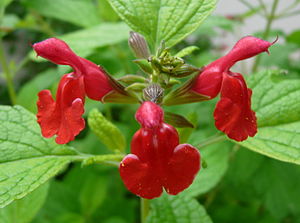Note: This is a project under development. The articles on this wiki are just being initiated and broadly incomplete. You can Help creating new pages.
Salvia microphylla - Baby sage
Salvia microphylla (Baby sage, Graham's sage, Blackcurrant sage) is a perennial shrub found in the wild in southeastern Arizona and the mountains of eastern, western, and southern Mexico. It is a very complex species which easily hybridizes, resulting in numerous hybrids and cultivars brought into horticulture since the 1990s. The specific epithet microphylla, from the Greek, means "small leaved". In Mexico, it is called "mirto de montes," or "myrtle of the mountains."
Description
Salvia microphylla grows to 1 to 1.3 m (3.3 to 4.3 ft) tall and wide, blooming in its first year and growing to full size in its second year. The leaves are ovate shaped, of varying sizes, and smooth or lightly covered with hairs. When crushed, the leaves have a strong fragrance, which has been described as pleasant and mint-like, but also as similar to that of blackcurrants, leading to the use of "Blackcurrant Sage" as an English name for this species.[1] It sometimes spreads underground, producing dense patches.
Along with its cultivars and hybrids, S. microphylla blooms heavily in late spring and again in autumn, with sporadic flowering year-round in mild conditions. The flowers are arranged in whorls, with a wide range of color: magenta, red, pink, and rose.
Uses
- Salvia microphylla is grown in central Mexico as a medicinal plant, and used for making tea.
- An infusion of the flowers and leaves have been used in the treatment of fevers[2]
Common name
- English - Baby sage
